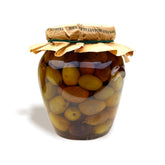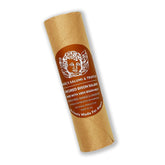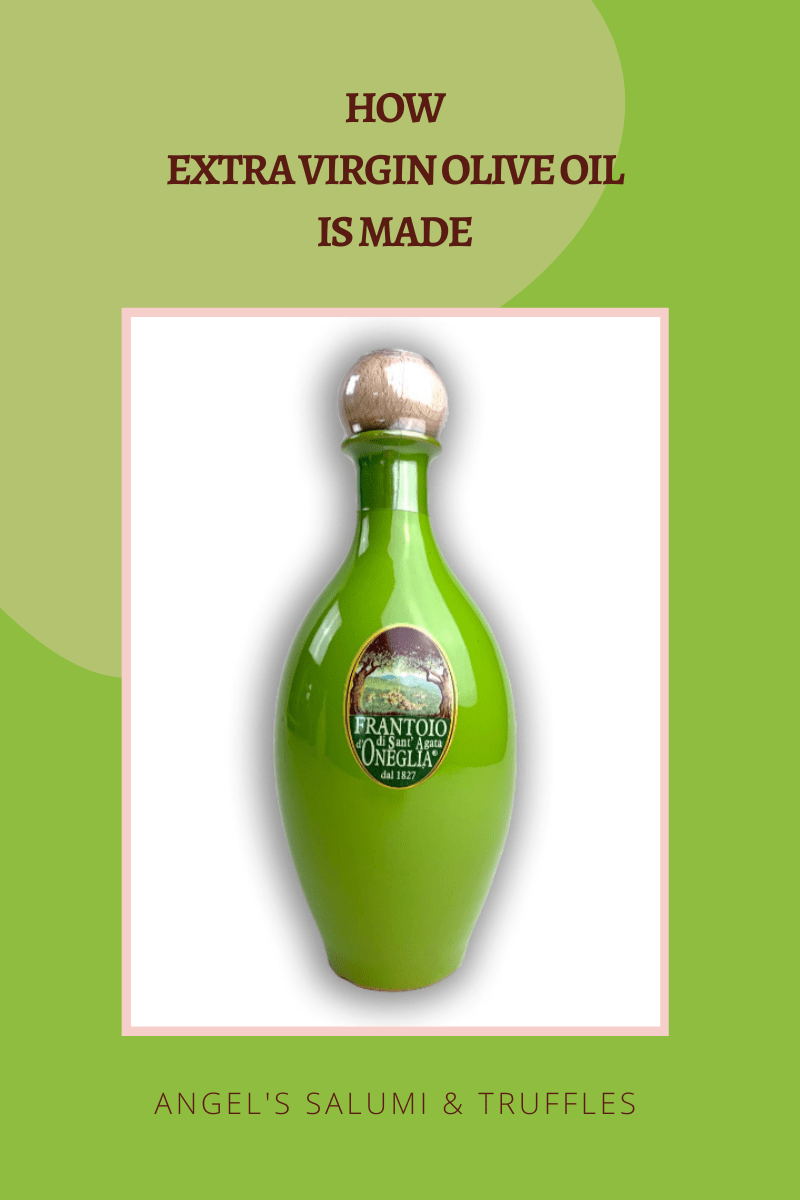How Extra Virgin Olive Oil Is Made
Extra virgin olive oil is tantamount to liquid gold in Italy. It is a necessary and beneficial part of the Mediterranean diet, one that is rich in antioxidants and healthy fats. But, even with its benefits and incredible flavor, you may find yourself wondering why extra virgin olive oil is so highly touted (and priced), in comparison to regular olive oil.
The reason extra virgin olive oil is so popular comes down to it being the highest quality olive oil available, which is a result of how it is made. Extra virgin olive oil is extracted from the fruit of an olive tree without the use of any heat or solvents, and its production process is governed by the highest of organoleptic and chemical standards.
It is because of the adherence to these strict stipulations that extra virgin olive oil remains the most flavorful and healthy of all nine grades of olive oil. The process by which extra virgin olive oil is made and the chemical and organoleptic assessments it must undergo makes it the highest grade, and most expensive, type of olive oil.
And, it is worth every bit of effort to produce and every penny to buy.

What Does “Extra Virgin” Mean?
The International Olive Council, one of the primary entities governing the production of olive oil, defines extra virgin olive oil as having a median of defects (a median score of one of the twelve olive oil defects) as being zero and the median of fruitiness higher than zero. In order to be considered “extra virgin”, the olive oil must, “have a free acidity, expressed as oleic acid, of not more than 0.80 grams per 100 grams, and the other physico-chemical and organoleptic characteristics of which correspond to those fixed for this category in this standard.”
In addition to the chemical parameters, olive oil is judged on a list of three positive attributes and absence of five common defects as method of determining its classification as an “extra virgin” olive oil.
A linear scale is used to measure the three positive attributes that constitute the oil as being an extra virgin olive oil. These attributes are fruitiness, bitterness, and pungency.
The fruitiness of extra virgin olive oil is determined by its aroma and flavor. In general, quality extra virgin olive oil tastes fresh, ripe, green, and mature.
Bitterness, in contrast, is a taste less preferred in most foods and is one that is perceived as sharp on the tongue. While this flavor is not something most people are keen on in other foods, in extra virgin olive oil, a subtle bitterness means the oil was produced with fresh olives and contains an abundance of polyphenols. These are natural compounds of various chemical structures that are thought to decrease morbidity and/or slow progression of cardiovascular and neurodegenerative diseases, as well as some types of cancer. They also contain antioxidant properties.
Finally, the pungency, is the slight burning or stinging sensation felt in the back of the throat resulting from the presence of particular types of polyphenols. Pungency, much like bitterness, is an acquired taste that can take some time to become familiar with.
These three primary flavor attributes must be carefully balanced to produce a high-quality extra virgin olive oil that is rich in both flavor and nutritious benefits.

How is Extra Virgin Olive Oil Made?
The difficult and effort-intensive production process makes extra virgin olive oil the elixir so highly coveted around the world that it is.
The chemical structure and composition of the olives begin to sensibly transform as the fruit matures. The maturation stage of the olive is influenced by the olive variety, soil and climate in which they were grown, and the cultivation practices that were used.
The optimal harvest time for olives is when veraison first begins – when the fruit changes color. The olives are harvested either by-hand or through the use of machinery once the temperature has cooled for the day, as picking the olives in a colder environment helps to preserve the polyphenols. The olives are then immediately brought to the mill.
After arriving at the mill, the freshly harvested olives are stripped of their leaves, washed, and sent to the grinder. Traditional olive oil mills use millstones, while modernized mills use a hammer, mechanical blade, or a disk mill.
Once the olives are ground into paste, they are spread over stacked fiber disks and set into a press. The press then comes down, applying pressure to the paste to squeeze the vegetal liquid from the olive paste. This vegetal liquid contains a significant amount of water that must be removed, as the presence of water accelerates the organic degeneration caused by various microorganisms.
The removal of the water is done through the use of a centrifuge, with the liquid being run through the centrifuge twice to ensure the water and pomace particles have been completely separated out.
Once this is complete, the oil is then filtered and/or stored in a tank under inert gas, which is non-reactive. If the virgin olive oil meets the stipulations for extra virgin olive oil, then it will be labeled as being extra virgin olive oil.

The Best Types of Extra Virgin Olive Oil
From mixing with salt and pepper as bread garnishing to drizzling over dry-cured meats or using in a salad, extra virgin olive oil is a seemingly ubiquitous ingredient that can be found in nearly any kitchen.
The best types of extra virgin olive oil started with the highest quality ingredients.
1. Frantoio Di Sant’agata D'Oneglia "I Clivi" Extra Virgin Olive Oil
This premium extra virgin olive oil is made with cold-pressed Taggiasca olives that were grown 200-500 meters above sea level along the coast of Liguria. The “I Clivi” Extra Virgin Olive Oil boasts a strong flavor and smooth appearance. The natural, 99% extra virgin olive oil was hand-pressed and infused with 1% green almonds and green thistle for a finished product containing less than 0.5% acidity.
2. Frantoio Di Sant’agata D’Oneglia “Buon Frutto” Extra Virgin Olive Oil
The Frantoio “Buon Frutto” Extra Virgin Olive Oil is hand-pressed, made with cold-pressed Taggiasca olives grown several hundred meters above sea level along the Ligurian coast. The natural, 99% extra virgin olive oil is infused with 1% sweet almonds, pine nuts, and artichoke for a finished oil that holds less than 0.3% acidity.
3. Chili Pepper Mosto Extra Virgin Olive Oil
The Frantoio Di Sant’agata D’Oneglia Chili Pepper Mosto Olive Oil is made with cold-pressed Taggiasca olives grown 200-500 meters above sea level along the coast of Liguria. This Extra Virgin Chili Pepper Mosto Olive Oil has a strong flavor and full-bodied appearance, being 99% extra virgin olive oil infused with 1% fresh chili pepper during traditional hand-pressing for less than 0.5% acidity.
4. Lemon Extra Virgin Olive Oil
The Frantoio Di Sant’agata D’Oneglia Extra Virgin Olive Oil With Lemon is 99% extra virgin olive oil made with cold-pressed Taggiasca olives from the Ligurian coast and infused with 1% fresh lemon during traditional hand-pressing. This extra virgin olive oil with lemon has less than 0.5% acidity and is beautiful on meat, fish carpaccio, and salads.
5. Black Truffle Extra Virgin Olive Oil
Maison Crayssac Black Truffle Olive Oil is the perfect blend of Italian extra virgin olive oil and black truffle aroma (Tuber Melanosporum), with black truffle peelings used to perfume the oil.
6. White Truffle Extra Virgin Olive Oil
Maison Crayssac White Alba Truffle Olive Oil is the perfect blend of Italian Extra Virgin Olive Oil and White Alba Truffle Aroma (Tuber Magnatum Pico), using White Alba Truffle peelings to perfume the extra virgin olive oil.
7. Blood Orange Extra Virgin Olive Oil
Maison F. Crayssac Blood Orange Extra Virgin Olive Oil is made with organic, extra virgin olive oil and beautiful, natural blood orange aroma. This blood orange extra virgin olive oil has a strong citrus flavor, a full and smooth appearance, and an intense character. The natural extra virgin olive oil is enhanced with fresh blood oranges during traditional hand-pressing, giving the oil less than 0.5% acidity.

Where to Find Quality Extra Virgin Olive Oil
When looking for high quality extra virgin olive oil, especially the infused extra virgin olive oils, specialty and artisan food stores will be your best option. At Angel’s Salumi & Truffles, we have several kinds of extra virgin olive oil, including fruit-infused extra virgin olive oil and even some sundried tomatoes in extra virgin olive oil..
Come on into the store to see our other charcuterie options (especially when planning a Thanksgiving charcuterie board) and browse our selections of extra virgin olive oil.






